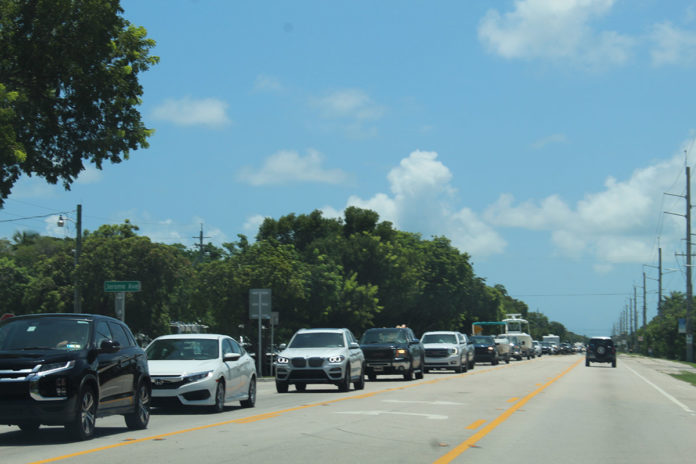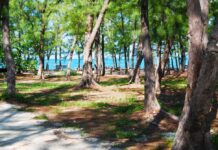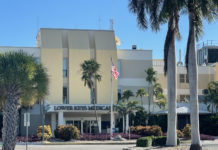
The idea of capacity arises often when talking about our quality of life in the Keys, but it has different meanings. Let’s take a closer look at Keys’ capacity, and key factors that may influence our thinking about it.
Simply put, capacity is how much a given container can hold — pour 10 ounces of water into an 8- ounce glass to experience being over capacity. But in the Keys, the idea of capacity isn’t as clear. In this essay, think of our container as all of Monroe County, and the quantity as the number of people (residents and visitors) here at any one time.
Some think we’re over capacity, while others believe there’s still room for growth, i.e. we’re under capacity. Our community is divided on this question.
FloridaCommerce’s 2023 Hurricane Evacuation Model and local governments’ responses to it have been in the news recently. While hurricane evacuation time is important to consider when thinking about our capacity, it is far from the only meaningful factor. Let’s also consider waste water and its effect on the environment, fresh water, traffic and housing, all of which weigh on our quality of life.
Waste water
People flush toilets, and the more people we have, the more toilets flush. That waste water has to go somewhere. While the infrastructure for processing our waste water has been improved, harmful toxins are still being discharged into nearshore waters, impacting the marine life on which tourism depends.
Fresh water
All the fresh water we use to drink, cook, bathe, clean, water plants, and yes, flush those toilets, comes to us via a single pipeline from the mainland. Multiple breaks in that pipe in 2023 highlighted its fragility (it is being replaced, slowly, at great cost), and necessitated reduced water pressure to our homes. Further demand for water, especially during peak tourism periods, risks more pipe failures and even further pressure reductions.
Traffic
Nearly everyone in the Keys is delayed, inconvenienced or otherwise unhappy with congestion on U.S. 1. Continuous construction (like the pipeline replacement project) and several single-lane sections of the road add to delays. Some sections of the road received failing grades (which would entail capping some development) in a 2023 study that was shelved by the county commission. We all agree that traffic is bad now, and has gotten worse in recent years. Congestion isn’t just inconvenient; it lengthens first-responder arrival times and necessary trips to the mainland for medical treatment.
Tourism and housing
New construction is limited by law, but demand for visitor housing continues to grow. Our economy depends on tourism, and relentless and successful tourist tax-funded promotion of the Keys has driven hotel room rates to levels unimagined before the pandemic. Increased demand spurs current owners and speculating buyers to convert owner-occupied and long-term rental homes to short-term vacation rentals (some of which are illegal). Hospitality workers and professionals vital to our community (think teachers, first responders, health care professionals, municipal employees, retail workers, etc.) find it increasingly difficult to afford to live here, with rental rates rivaling those in Manhattan. Long-term renters lose their homes when property owners convert them to vacation rentals. And some employers have had to become landlords to attract and retain workers.
Legal limits on capacity
There are indeed legal limits on Keys capacity. Despite Florida’s emphasis on growth, the state Legislature years ago designated Monroe County and Key West as Areas of Critical State Concern, a legal designation that requires measures to control growth. The Rate of Growth Ordinance (ROGO) intends to ensure safe evacuation of residents and visitors in the event of an approaching hurricane, and also intends to protect the Keys’ natural resources. Residential building permits released under ROGO are awarded through a scoring mechanism called the Building Permit Allocation System (BPAS). With thousands of buildable vacant lots in the Keys, demand for building permits always exceeds the available supply.
FloridaCommerce, a state agency, updates the Hurricane Evacuation Model every 10 years to predict how long it would take to safely evacuate the Keys. The current cycle of this process began in 2023 and will continue through 2024, with the outcome determining whether and how many additional building permits will be released to local governments via BPAS. It’s political. Developers and property owners want more, some community members want none or fewer, and the county and its municipalities must balance these strongly voiced sentiments, as well as the real risk of significant financial liability (to be borne by taxpayers) under so-called “takings” lawsuits filed by property owners who are denied building permits for their lot.
Opponents of new permits contend that the evacuation model is flawed, notably in assumptions used in its complex formulas. Recent and frequent instances of rapid intensification of tropical storms into hurricanes, uncertainty of human behavior, traffic and construction on both U.S. 1 and the mainland, and myriad other factors not clearly outlined in the model cast doubt on whether we could safely evacuate everyone before an approaching dangerous storm.
Does capacity matter to you?
Everyone’s quality of life is affected by capacity challenges here. Perhaps your living costs have gone up or even caused you to think of moving away. You may have a longer commute. Water pressure is lower than it was a year ago. And our precious corals are dying.
Whether you believe that growth should proceed without limits, be carefully managed within practical considerations or curtailed altogether, your voice in this community matters, and will make a difference in how critical policy decisions affecting us all will play out. But only if you speak up. Your vote is vital, but so is your active participation by attending commission meetings, donating to, joining and volunteering with one of our many advocacy groups, or even running for office yourself. Our voices now can mean big changes in our future.
Robert S. Gold
Robert S. Gold lives in Key West and serves on the board of directors of the community advocacy group Last Stand.





















